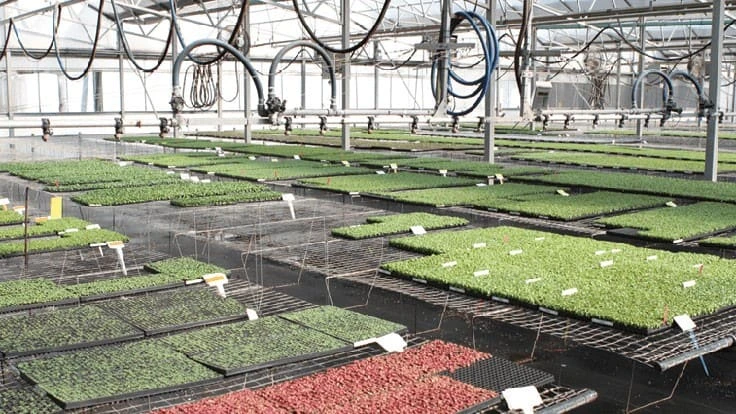

Most commercial greenhouses are year-round operations. Bedding plants, mums, poinsettias, tropical foliage and succulents are just some examples of the diversity of crops that can be produced throughout the year in greenhouses throughout the country.
One of the biggest challenges in greenhouse production is time management and scheduling time off. When we can find a few extra days for some rest and relaxation, those pest and pathogens don’t ever seem to have the same idea to go on vacation, too. When plants, debris or even just soil particles are present, the potential for pathogens is extremely high. Plant pathogens don’t stop for vacation even when greenhouses are empty.
Although plant pathogens don’t go on vacation, they do have the ability to survive in the absence of food or under unfavorable conditions for long periods of time, even years. Many fungi, including some of the most economically important greenhouse pathogens, can produce thick-walled structures that are very resilient to adverse environmental conditions.
Some common examples include sclerotia of Botrytis, chlamydospores produced by Fusarium and the infamous oospores of Pythium and Phytophthora. All of these are often referred to as overwintering structures when it comes to being outdoors, but that doesn’t mean they can’t be produced in a greenhouse environment, especially when they are not happy. These are survival mechanisms that make plant pathogens even more challenging to control.

What makes fungal disease outbreaks happen?
Environmental conditions are the driving force behind disease outbreaks. Unfortunately, some of the same environmental conditions that favor plant growth are ideal for pathogens and disease development.
However, just like with plants, the conditions that are considered favorable for some pathogens may not be the same for others. For example, the soft rot bacterium Dickeya chrysanthemi (aka Erwinia) thrives under warm conditions where disease is widely reported with temperatures exceeding 90° F. Conversely, outbreaks of downy mildew, caused by Peronospora lamii, thrive in temperatures at or below 60° F.
One of the greatest benefits to growing plants in a greenhouse is having control of the environment, which is vital for disease management.

Monitoring temperature and moisture
The survival and performance of most plant pathogens depend greatly on the prevailing conditions of temperature and moisture or on the presence of water in their environment.
Irrigation practices inside the greenhouse are often responsible for the spread and development of plant disease. The use of overhead irrigation is a highly effective way to spread plant pathogens on and between plants. Wet leaves are favorable for most plant pathogens, and the longer the leaves remain wet, the greater the chance for disease.
Thus, the use of fans and adequate spacing between pots is important to dry out the plant canopy. Irrigation events should be timed to allow for the foliage to completely dry out between watering events.
Sanitation and cleanliness crucial
Along with controlling environmental conditions, reducing the number of pathogens that are present is critical. Starting clean and staying clean reduces the pathogen population and potential for disease outbreaks.
Diseased plants serve as a reservoir of pathogens, so it’s important to remove and discard all diseased plant material including used pots and media.
Sanitizing the greenhouse and thorough cleaning between crops when the houses are empty, is a proven and effective way to reduce pathogens. There are commercially available disinfectants that should be used to clean surfaces and kill pathogens that are present. If there is any evidence of dirt, it’s safe to assume there are microscopic plant pathogens too.
When symptoms of disease appear, it’s best to get a diagnosis and keep records, so that the correct control strategies are put in place for the future. Plant host and variety, time of symptom development and photo documentation of the incident will be very useful for greenhouse records. Detailed and accurate records allow for making informed decisions, which is most often rewarding, as it pays off over time.
The application of pesticides is essential to minimize and control disease outbreaks, especially in enclosed environments like greenhouses that contain large populations of plant material.
Some pesticides offer both preventative and curative control, but the efficacy is generally increased the closer the application is to inoculation, which is when the pathogen comes in contact with the plant. The most effective disease control occurs when pesticide applications are made before the pathogen infects the plant or within a short period of time (i.e., 24 to 48 hours) after contact. Choosing highly effective products and using them according to the manufacturer’s label will ensure positive results.

The bottom line
Unfortunately, pathogens don’t ever seem to take a rest, but with a little extra planning and management, you can take a few well-deserved days away. Please be sure to check out our SePro product portfolio, as SePRO offers highly effective solutions for managing pests and diseases in the greenhouse.

Explore the February 2022 Issue
Check out more from this issue and find your next story to read.
Latest from Greenhouse Management
- Anthura acquires Bromelia assets from Corn. Bak in Netherlands
- Top 10 stories for National Poinsettia Day
- Langendoen Mechanical hosts open house to showcase new greenhouse build
- Conor Foy joins EHR's national sales team
- Pantone announces its 2026 Color of the Year
- Syngenta granted federal registration for Trefinti nematicide/fungicide in ornamental market
- A legacy of influence
- HILA 2025 video highlights: John Gaydos of Proven Winners





